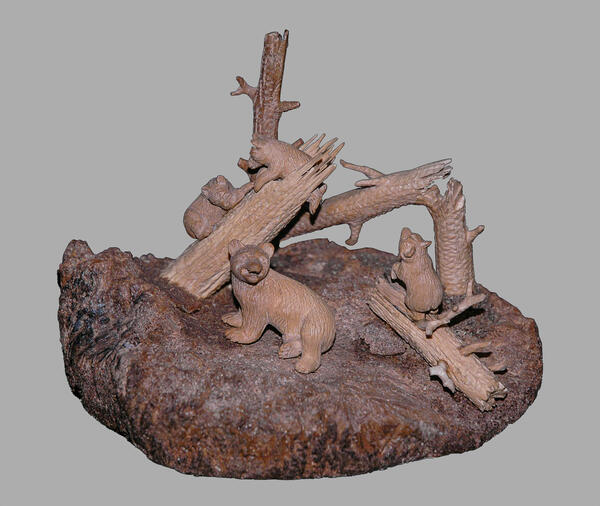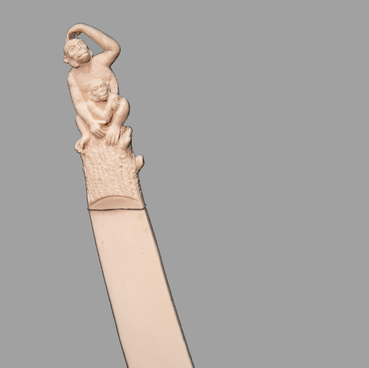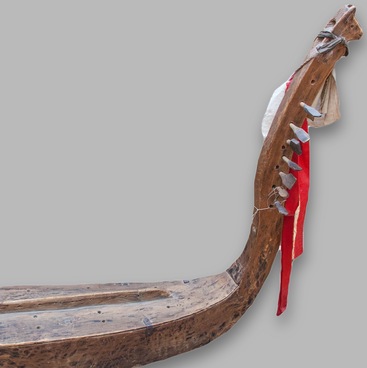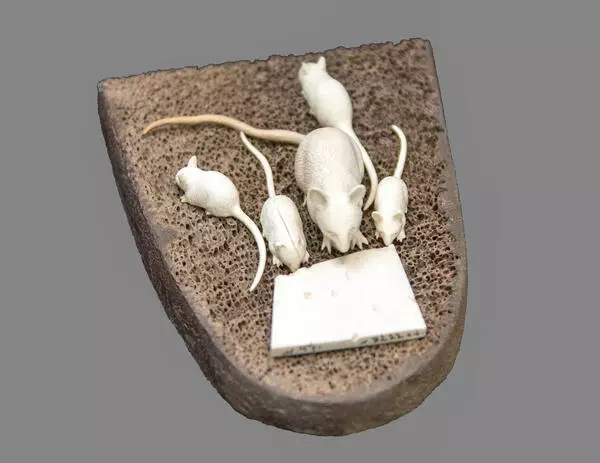In the collection of the Tobolsk Provincial Museum, there is a sculptural composition ‘Morning in the Pine Forest’ made by a local bone-cutting master Porfiriy Terentyev at the end of the 19th century from a mammoth tusk. The prototype of the work was the famous eponymous painting by Russian artists Ivan Shishkin and Konstantin Savitskiy.
Terentyev carved from the bones a bear with three cubs among the fallen trees. The sculptural composition almost completely repeats the poses and location of the bears in the picture, with the exception of the pose of the mother bear. She is not looking at one of the cubs, but at the viewer. Terentyev carved his work from a less valuable, brown mammoth bone. He was one of those who drew the attention of other masters to this material, which was considered unsuccessful.
The painting ‘Morning in the Pine Forest’ is one of the most recognizable in Russian art. The landscape was painted by the artist Ivan Shishkin, and the bears were created by the artist Konstantin Savitskiy based on Shishkin’s sketches. After the collector Pavel Tretyakov has purchased the painting, he removed Savitskiy’s signature from it: ‘Starting from the idea and ending with the execution, everything speaks about the manner of painting, about the creative method peculiar to Shishkin.’ The Russian Museum has preserved seven versions of pencil sketches with bears by Shishkin.
Ivan Shishkin (1832-1898) was born in Yelabuga, Vyatka province. He was a Russian landscape painter, graphic artist, printmaker and aquafortist, representative of the Dusseldorf Art School. His co-author Konstantin Savitskiy (1844-1905) was born in Taganrog. He was a Russian genre painter, academician, member of the Association of Traveling Art Exhibits.
Porfiriy Terentyev himself was a bone-cutting artist who came from the peasants of the village of Samara, Tobolsk District. As a teenager, he studied with the then famous Tobolsk artist Mikhail Znamenskiy, but due to circumstances, he had to leave his studies. During his military service, he became interested in the culture of the Ostyaks, the so-called Khanty, an indigenous Ugric people living in the North of Western Siberia. Terentyev carved their figures out of wood. On his return to Tobolsk, he began carving mammoth bones. The master’s only tool was a simple penknife. Terentyev was one of the first to introduce miniature genre sculpture to the Tobolsk bone-cutting school. His works were highly appreciated at the International Paris Exhibition in 1900.
Terentyev carved from the bones a bear with three cubs among the fallen trees. The sculptural composition almost completely repeats the poses and location of the bears in the picture, with the exception of the pose of the mother bear. She is not looking at one of the cubs, but at the viewer. Terentyev carved his work from a less valuable, brown mammoth bone. He was one of those who drew the attention of other masters to this material, which was considered unsuccessful.
The painting ‘Morning in the Pine Forest’ is one of the most recognizable in Russian art. The landscape was painted by the artist Ivan Shishkin, and the bears were created by the artist Konstantin Savitskiy based on Shishkin’s sketches. After the collector Pavel Tretyakov has purchased the painting, he removed Savitskiy’s signature from it: ‘Starting from the idea and ending with the execution, everything speaks about the manner of painting, about the creative method peculiar to Shishkin.’ The Russian Museum has preserved seven versions of pencil sketches with bears by Shishkin.
Ivan Shishkin (1832-1898) was born in Yelabuga, Vyatka province. He was a Russian landscape painter, graphic artist, printmaker and aquafortist, representative of the Dusseldorf Art School. His co-author Konstantin Savitskiy (1844-1905) was born in Taganrog. He was a Russian genre painter, academician, member of the Association of Traveling Art Exhibits.
Porfiriy Terentyev himself was a bone-cutting artist who came from the peasants of the village of Samara, Tobolsk District. As a teenager, he studied with the then famous Tobolsk artist Mikhail Znamenskiy, but due to circumstances, he had to leave his studies. During his military service, he became interested in the culture of the Ostyaks, the so-called Khanty, an indigenous Ugric people living in the North of Western Siberia. Terentyev carved their figures out of wood. On his return to Tobolsk, he began carving mammoth bones. The master’s only tool was a simple penknife. Terentyev was one of the first to introduce miniature genre sculpture to the Tobolsk bone-cutting school. His works were highly appreciated at the International Paris Exhibition in 1900.




